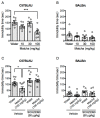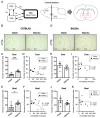Matcha Tea Powder's Antidepressant-like Effect through the Activation of the Dopaminergic System in Mice Is Dependent on Social Isolation Stress
- PMID: 36771286
- PMCID: PMC9921318
- DOI: 10.3390/nu15030581
Matcha Tea Powder's Antidepressant-like Effect through the Activation of the Dopaminergic System in Mice Is Dependent on Social Isolation Stress
Abstract
Matcha tea powder is believed to have various physiological benefits; however, its detailed mechanism of action has been poorly understood. Here, we investigated whether the mental state of mice, due to social isolation stress, affects the antidepressant-like effect of Matcha tea powder by using the tail suspension test. Oral administration of Matcha tea powder reduced the duration of immobility in the stress-susceptible C57BL/6J strain, but not in BALB/c strain. In C57BL/6J mice, SCH23390, a dopamine D1 receptor blocker, prevented Matcha tea powder from exerting its antidepressant-like effect. Matcha tea powder also increased the number of c-Fos-positive cells in the prefrontal cortex (PFC) region and the nucleus accumbens (NAc) region in C57BL/6J mice, but not in BALB/c mice. In contrast, Matcha tea powder did not change the number of c-Fos-positive cells in the ventral tegmental area (VTA) region. Notably, C57BL/6J mice with a shorter immobility time had a higher number of c-Fos-positive cells in the PFC, NAc, and VTA regions. However, no such correlation was observed in the stress-tolerant BALB/c mice. These results suggest that Matcha tea powder exerts an antidepressant-like effect through the activation of the dopaminergic system including the PFC-NAc-VTA circuit and that mental states are important factors affecting the physiological benefits of Matcha tea powder.
Keywords: BALB/c; C57BL/6J; Matcha; depression; dopaminergic circuit.
Conflict of interest statement
The authors declare no potential conflict of interest with respect to the research and/or publication of this article.
Figures







Similar articles
-
Participation of the nucleus accumbens dopaminergic system in the antidepressant-like actions of a diet rich in omega-3 polyunsaturated fatty acids.PLoS One. 2020 Mar 25;15(3):e0230647. doi: 10.1371/journal.pone.0230647. eCollection 2020. PLoS One. 2020. PMID: 32210469 Free PMC article.
-
Three Weeks Daily Intake of Matcha Green Tea Powder Affects Substrate Oxidation during Moderate-Intensity Exercise in Females.J Diet Suppl. 2021;18(5):566-576. doi: 10.1080/19390211.2020.1811443. Epub 2020 Sep 2. J Diet Suppl. 2021. PMID: 32875933 Clinical Trial.
-
Fluoride Content of Matcha Tea Depending on Leaf Harvest Time and Brewing Conditions.Nutrients. 2022 Jun 20;14(12):2550. doi: 10.3390/nu14122550. Nutrients. 2022. PMID: 35745280 Free PMC article.
-
A review on matcha: Chemical composition, health benefits, with insights on its quality control by applying chemometrics and multi-omics.Food Res Int. 2023 Aug;170:113007. doi: 10.1016/j.foodres.2023.113007. Epub 2023 May 23. Food Res Int. 2023. PMID: 37316075 Review.
-
A comprehensive review of matcha: production, food application, potential health benefits, and gastrointestinal fate of main phenolics.Crit Rev Food Sci Nutr. 2024;64(22):7959-7980. doi: 10.1080/10408398.2023.2194419. Epub 2023 Apr 3. Crit Rev Food Sci Nutr. 2024. PMID: 37009832 Review.
Cited by
-
Relationship Between Depression and Epigallocatechin Gallate from the Perspective of Gut Microbiota: A Systematic Review.Nutrients. 2025 Jan 12;17(2):259. doi: 10.3390/nu17020259. Nutrients. 2025. PMID: 39861389 Free PMC article.
References
-
- Depression. [(accessed on 5 December 2022)]. Available online: https://www.who.int/news-room/fact-sheets/detail/depression.
MeSH terms
Substances
Grants and funding
LinkOut - more resources
Full Text Sources
Medical
Miscellaneous

